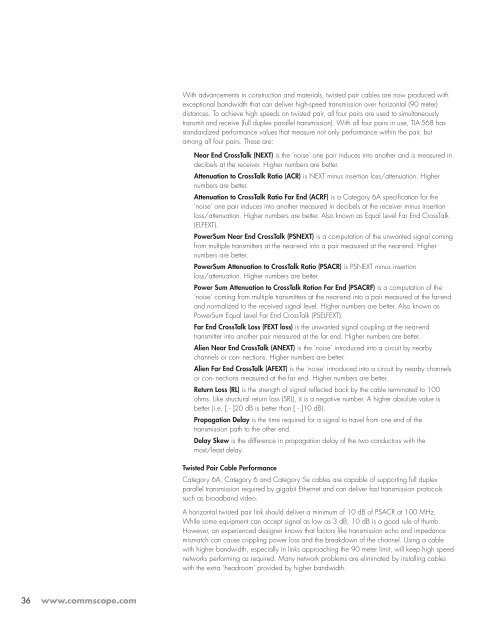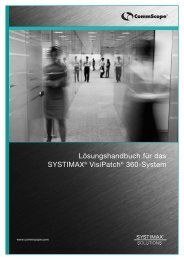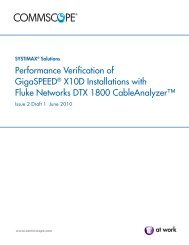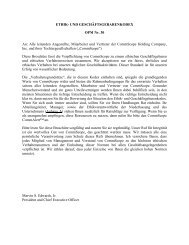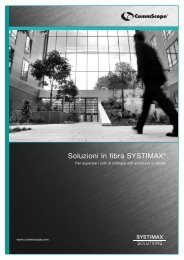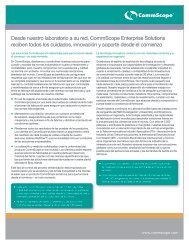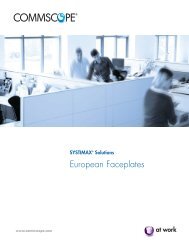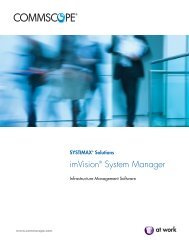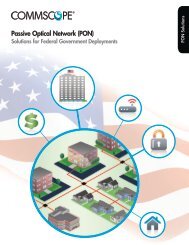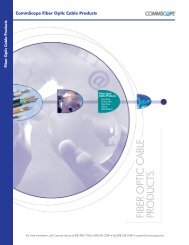CommScope® Enterprise Data Center Design Guide - Public ...
CommScope® Enterprise Data Center Design Guide - Public ...
CommScope® Enterprise Data Center Design Guide - Public ...
Create successful ePaper yourself
Turn your PDF publications into a flip-book with our unique Google optimized e-Paper software.
36<br />
www.commscope.com<br />
With advancements in construction and materials, twisted pair cables are now produced with<br />
exceptional bandwidth that can deliver high-speed transmission over horizontal (90 meter)<br />
distances. To achieve high speeds on twisted pair, all four pairs are used to simultaneously<br />
transmit and receive (full duplex parallel transmission). With all four pairs in use, TIA-568 has<br />
standardized performance values that measure not only performance within the pair, but<br />
among all four pairs. These are:<br />
Near End CrossTalk (NEXT) is the ‘noise’ one pair induces into another and is measured in<br />
decibels at the receiver. Higher numbers are better.<br />
Attenuation to CrossTalk Ratio (ACR) is NEXT minus insertion loss/attenuation. Higher<br />
numbers are better.<br />
Attenuation to CrossTalk Ratio Far End (ACRF) is a Category 6A specification for the<br />
‘noise’ one pair induces into another measured in decibels at the receiver minus insertion<br />
loss/attenuation. Higher numbers are better. Also known as Equal Level Far End CrossTalk<br />
(ELFEXT).<br />
PowerSum Near End CrossTalk (PSNEXT) is a computation of the unwanted signal coming<br />
from multiple transmitters at the near-end into a pair measured at the near-end. Higher<br />
numbers are better.<br />
PowerSum Attenuation to CrossTalk Ratio (PSACR) is PSNEXT minus insertion<br />
loss/attenuation. Higher numbers are better.<br />
Power Sum Attenuation to CrossTalk Ration Far End (PSACRF) is a computation of the<br />
‘noise’ coming from multiple transmitters at the near-end into a pair measured at the far-end<br />
and normalized to the received signal level. Higher numbers are better. Also known as<br />
PowerSum Equal Level Far End CrossTalk (PSELFEXT).<br />
Far End CrossTalk Loss (FEXT loss) is the unwanted signal coupling at the near-end<br />
transmitter into another pair measured at the far end. Higher numbers are better.<br />
Alien Near End CrossTalk (ANEXT) is the ‘noise’ introduced into a circuit by nearby<br />
channels or con- nections. Higher numbers are better.<br />
Alien Far End CrossTalk (AFEXT) is the ‘noise’ introduced into a circuit by nearby channels<br />
or con- nections measured at the far end. Higher numbers are better.<br />
Return Loss (RL) is the strength of signal reflected back by the cable terminated to 100<br />
ohms. Like structural return loss (SRL), it is a negative number. A higher absolute value is<br />
better (i.e. [ - ]20 dB is better than [ - ]10 dB).<br />
Propagation Delay is the time required for a signal to travel from one end of the<br />
transmission path to the other end.<br />
Delay Skew is the difference in propagation delay of the two conductors with the<br />
most/least delay.<br />
Twisted Pair Cable Performance<br />
Category 6A, Category 6 and Category 5e cables are capable of supporting full duplex<br />
parallel transmission required by gigabit Ethernet and can deliver fast transmission protocols<br />
such as broadband video.<br />
A horizontal twisted pair link should deliver a minimum of 10 dB of PSACR at 100 MHz.<br />
While some equipment can accept signal as low as 3 dB, 10 dB is a good rule of thumb.<br />
However, an experienced designer knows that factors like transmission echo and impedance<br />
mismatch can cause crippling power loss and the breakdown of the channel. Using a cable<br />
with higher bandwidth, especially in links approaching the 90 meter limit, will keep high speed<br />
networks performing as required. Many network problems are eliminated by installing cables<br />
with the extra ‘headroom’ provided by higher bandwidth.


